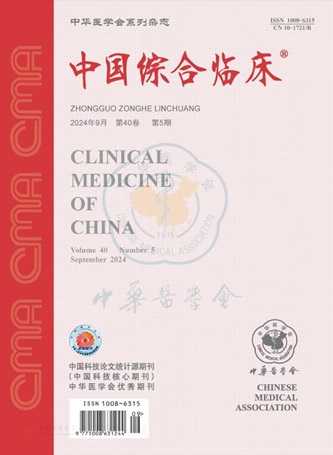p16和geminin在低级别鳞状上皮内病变进展中的临床价值
引用次数: 0
摘要
目的分析p16(p16ink4a)、细胞周期因子gemin和Ki-67在低级别鳞状上皮内病变(LSIL)中的阳性表达水平,进一步探讨这些指标对LSIL患者进展的评估能力。方法回顾性分析2015年1月至2018年6月上海市嘉定区中心医院276例宫颈标本,选择148例LSIL患者。根据二次检查结果,将LSIL患者分为三组:(1)无病变(自然消退)组90例;(2) LSIL持续组38例;(3) 高级别鳞状上皮内病变(HSIL)组20例。对第一次活检组织进行免疫组化,计算p16、geminin和Ki-67的相对阳性率。斯皮尔曼相关性分析确定了上述指标与疾病进展之间的相关性;ROC曲线用于计算每个指标的最佳诊断值,并包括多变量逻辑回归分析,以探讨上述指标评估患者进展为HSIL风险的能力。结果HSIL组p16(51.26±17.15)%、geminin相对阳性率(45.92±15.70)%高于LSIL组(43.71±11.84)%、(21.68±14.47)%和回归组(17.92±9.60)%,Spearman相关性分析显示,p16(r=0.27,P=0.014)和geminin(r=0.44,P<0.001)的相对阳性率与疾病进展呈显著正相关。在ROC曲线下,p16、geminin和Ki-67的最佳诊断值分别为38.9%、32.5%和18.6%。多因素logistic回归分析显示,p16的相对阳性率高于38.9%(OR=4.366,P=0.006),geminin高于32.5%(OR=5.392,P=0.011)具有更高的进展为HSIL的风险。结论p16和geminin可能是鉴别晚期LSIL患者的有效生物标志物。关键词:p16;细胞周期因子geminin;Ki-67;低度鳞状上皮内病变;高级鳞状上皮内病变本文章由计算机程序翻译,如有差异,请以英文原文为准。
Clinical value of p16 and geminin in the progress of patients with low-grade squamous intraepithelial lesions
Objective
To analyze the positive expression levels of p16 (p16ink4a), cell cycle factor geminin and Ki-67 in low-grade squamous intraepithelial lesions (LSIL), and to further explore the ability of these indicators to evaluate the progression of LSIL patients.
Methods
From January 2015 to June 2018, 276 cervical specimens from Jiading District Central Hospital of Shanghai were retrospectively studied, and 148 LSIL patients were selected.According to the results of the second examination, LSIL patients were divided into three groups: (1) no lesion (natural regression) group 90 cases; (2) LSIL persistent group 38 cases; (3) high-grade Squamous Intraepithelial Lesion (HSIL) group 20 cases.Immunohistochemistry was performed on the first biopsy tissues and the relative positive ratios of p16, geminin and Ki-67 were calculated.Spearman correlation analysis identified the correlation between the above indicators and the progress of the disease; ROC curve was used to calculate the best diagnostic value of each indicator, and multivariate logistic regression analysis was included to explore the ability of the above indicators to assess the risk of patients progressing to HSIL.
Results
In the HSIL group, p16 (51.26±17.15)%, geminin relative positive ratio (45.92±15.70) % was higher than those in the LSIL group((43.71±11.84)%, (21.68±14.47)%) and regression group((17.92±9.60)%, (0.16±0.03)%). The difference were statistically significant (F=2.922, 2.751, all P<0.05). Spearman correlation analysis showed that the relative positive ratio of p16 (r=0.27, P=0.014) and geminin (r=0.44, P<0.001) presented a notable positive correlation with the progression of the disease.Under the ROC curve, the best diagnostic values of p16, geminin and Ki-67 were 38.9%, 32.5% and 18.6%, respectively.Multivariate logistic regression analysis showed that the relative positive ratio of p16 was higher than 38.9% (OR=4.366, P=0.006), and geminin was higher than 32.5% (OR=5.392, P=0.011) had a higher risk of progression to HSIL.
Conclusion
p16 and geminin may be effective biomarkers for identifying patients with advanced LSIL.
Key words:
p16; Cell cycle factor geminin; Ki-67; Low-grade squamous intraepithelial lesions; High-grade squamous intraepithelial lesions
求助全文
通过发布文献求助,成功后即可免费获取论文全文。
去求助
来源期刊
CiteScore
0.10
自引率
0.00%
发文量
16855
期刊介绍:
Clinical Medicine of China is an academic journal organized by the Chinese Medical Association (CMA), which mainly publishes original research papers, reviews and commentaries in the field.
Clinical Medicine of China is a source journal of Peking University (2000 and 2004 editions), a core journal of Chinese science and technology, an academic journal of RCCSE China Core (Extended Edition), and has been published in Chemical Abstracts of the United States (CA), Abstracts Journal of Russia (AJ), Chinese Core Journals (Selection) Database, Chinese Science and Technology Materials Directory, Wanfang Database, China Academic Journal Database, JST Japan Science and Technology Agency Database (Japanese) (2018) and other databases.

 求助内容:
求助内容: 应助结果提醒方式:
应助结果提醒方式:


